Garden snakes are medium-sized snakes and are usually called garter snakes. These reptiles are not dangerous, but have an extremely mild venomous saliva that helps subdue their prey.
The common garter snake measures 22 to 54 inches long, including the tail. Its base can be black, brown, or green, and its stripes are yellow. Other garden snakes can have different color patterns, including olive, orange, or red.
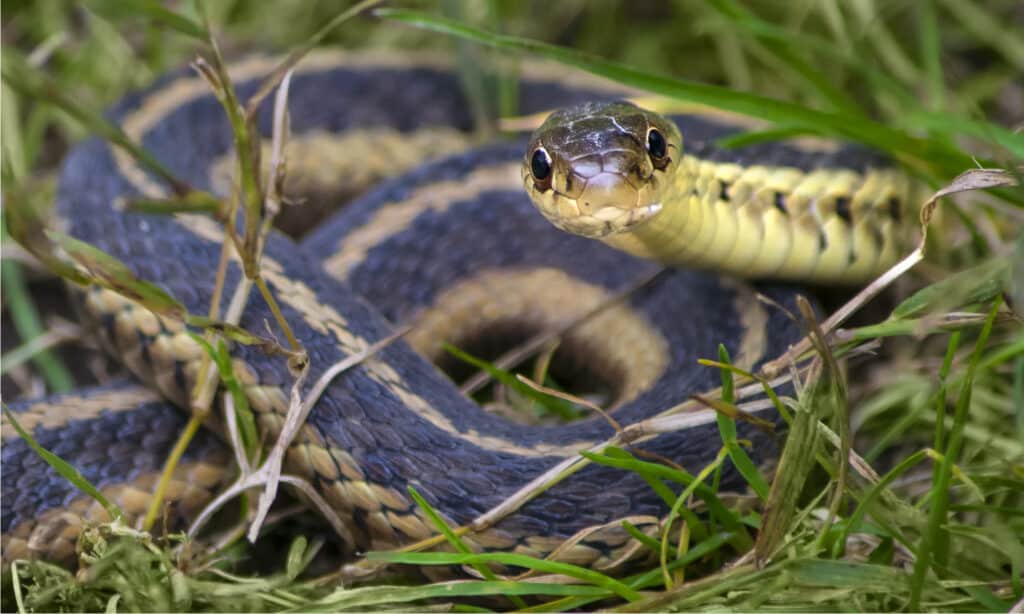
Garden snakes are not considered a threat to humans because the amount of venom their bites carry is very small.
©K Quinn Ferris/Shutterstock.com
Where Do Garden Snakes Live?
Garden snakes are native to North and Central America. Douglas Athon Rossman states that garter snakes are the most common and most successful in North America in terms of distribution and quantity. They can be found in every state in the mainland United States and Canada, from the Maritime Provinces to British Columbia. They also inhabit Mexico.
If you live in one of the areas mentioned above, we bet you’re wondering how to keep garden snakes out of your yard or garden. No one likes to hear or see a snake nearby during a relaxing summer day. Whether you’re afraid of snakes or just want to avoid crossing paths with them, we’re here to help you out!
Are Garden Snakes Dangerous?
Before diving into some tips on how to keep garden snakes away from your yard and garden, let’s see if they are venomous or dangerous.
Garden snakes were considered a non-venomous species until the 2000s. Then it was discovered that their saliva contained a mild neurotoxic venom that can produce an anaphylaxis response in some people. They are still not considered a threat to humans because the amount of venom their bites carry is very small compared to that of other venomous snakes.
Because of their diet of poisonous animals, garter snakes are also likely poisonous. So, while their bite isn’t dangerous, eating a garter snake can make you, your kids, or your pets sick. Garter snakes are also one of the stinkiest snakes, and spread musk the moment you pick one up.
How Long Do Garden Snakes Live?
Garden snakes on average live for 4-5 years in the wild. A factor that could help them survive longer is that because garden snakes can eat venomous animals like the American toad and rough-skinned newt and absorb the toxins into their own bodies, it makes the snakes poisonous to predators such as birds.
In captivity, their lifespan is can be up to 10 years.
Garden Snakes vs. Ribbon Snakes
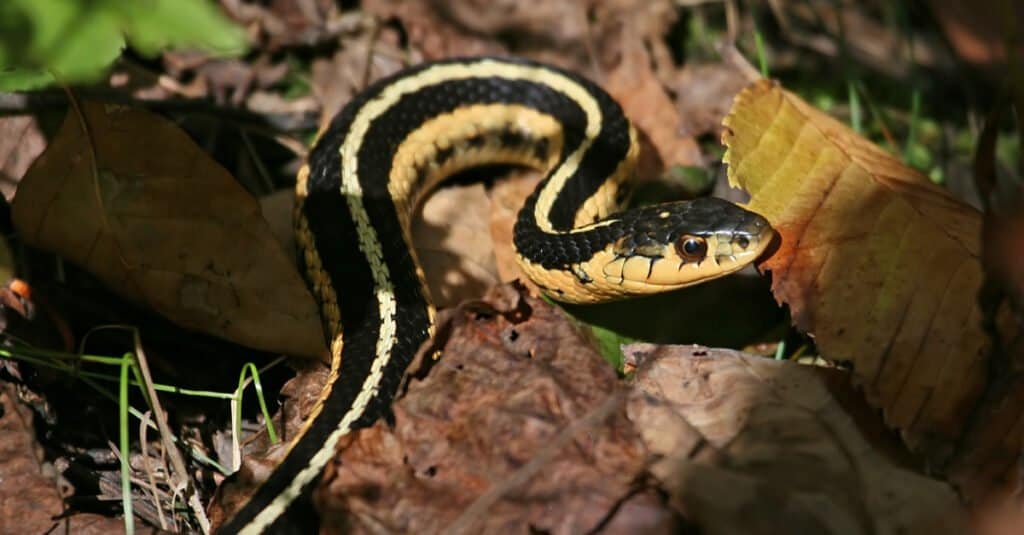
©John Czenke/Shutterstock.com
Before you take steps to deter snakes from your property, it’s a good idea to check that the snake you’re dealing with is indeed a garden snake. Garden snakes are very similar to ribbon snakes, a type of garter snake.
The main differences between ribbon snakes and garden snakes are their markings, colors, body shape, habitat and diet.
Garden snakes exist in a range of colors and patterns and have more distinct markings on their bodies, while ribbon snakes have fewer designs and colors. Ribbon snakes are thinner and have a head that’s lesss bulbous than garden snakes.
Both snake types live in humid climates and near water bodies. Ribbon snakes almost always choose to live near and around water but garden snakes also make woodland or grassland habitats their homes, so if you live in these regions you’re more likely to have the snakes present. A byproduct of living in these habitats is that garden snakes will eat small rodents more frequently than ribbon snakes, whose diet includes frogs, fish, and water bugs. To find out more about the differences between garden and ribbon snakes go here.
How to Keep Garden Snakes Out of Your Yard & Garden
Snake Repellents Probably Won’t Work
Snakes have a powerful sense of smell. However, snake repellent products and plants have never been proven to work. Many people consider commercial snake repellents effective. However, most snake experts say that’s not the case and if you want snakes out of your yard, get rid of the food sources and shelter.
Snake-Proof Fencing
Installing snake-proof fencing might be one step to consider if you’ve noticed snakes sneaking into your yard or garden. Snake-proof fencing is usually made from vinyl or hardware cloth, and its mesh is narrow enough that snakes can’t get past it. It needs to be installed in a way that prevents snakes from climbing the fence. If you’re not sure how to handle it, you can always contact a specialist to help you install the fence the right way.
Don’t Want Garden Snakes in Your Yard?
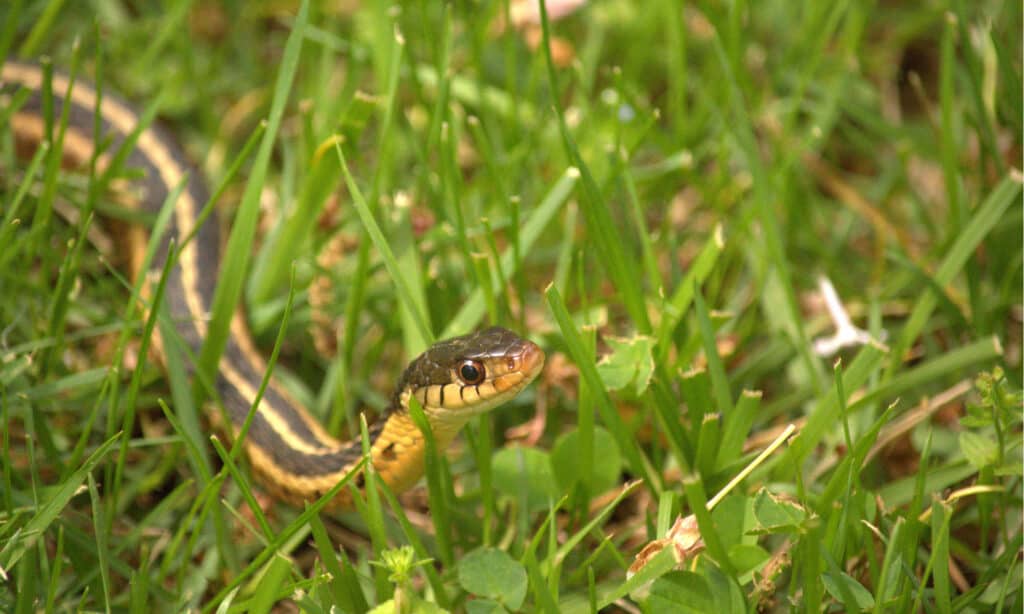
Garden snakes like to settle in grasslands, lawns, woodlands, and fields.
©Charlotte Payne/Shutterstock.com
Snakes will come to your yard or garden to look for water, food, or shelter. Garden snakes like to settle in grasslands, lawns, woodlands, and fields and are always near water sources. If you live in the western part of North America, it’s important to know that the snakes there are more aquatic than those in eastern North America.
Garden snakes eat small fish, slugs, earthworms, lizards, amphibians, birds, snails, and rodents.
Keep Grass Under Control and Add Plants That Their Prey Doesn’t Like
The best you can do is assess how “inviting” your yard or garden is to snakes. Keep the grass short. This will expose snakes to predators like hawks. It will also be easier for you to spot them. Avoid overwatering the grass because it will attract frogs, worms, and snakes. Plants like marigolds, wormwood, or lemongrass are natural repellents for some of the insects that garter snakes eat. Planting some around the house will also help.
Remove Any Potential Hiding Spots for Snakes
Check the exterior of your home and the yard or garden for hiding places, cracks, or holes. If you have woodpiles around the house, you should remove them, as snakes can easily hide in between them. Bird feeders can also be dangerous as they attract rodents, and snakes will come shortly after looking for prey.
What Should You Do If You Spot a Garden Snake in Your Yard or Garden?
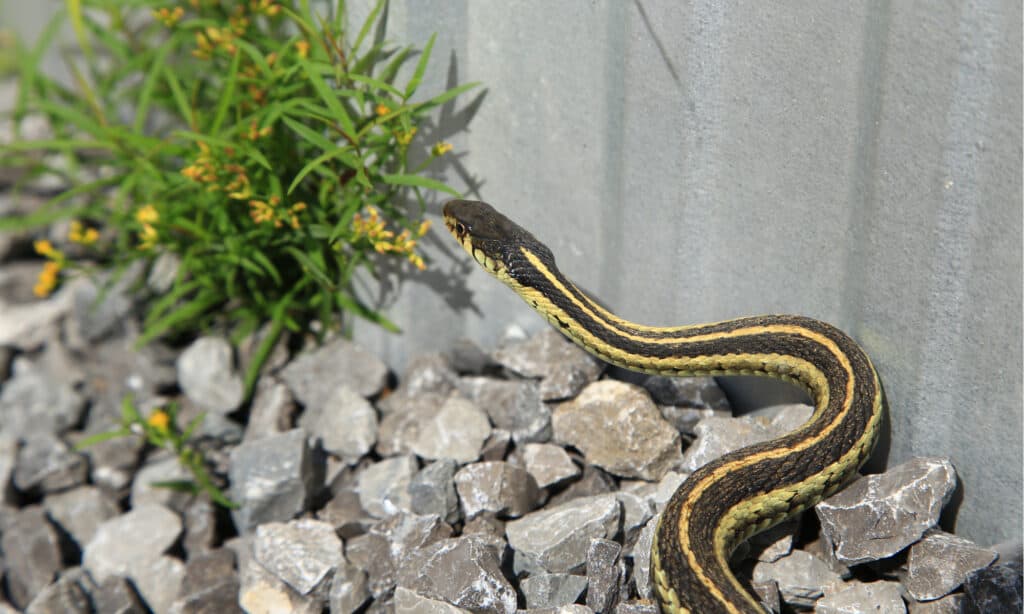
A garden snake bite can swell and hurt, but it’s not as dangerous as a
rattlesnake
bite.
©Alexander Gold/Shutterstock.com
Garter snakes are highly defensive. Do not try to touch or catch them if you spot any. It’s better to leave space between you and the snake. Otherwise, they will feel threatened.
Garden snakes are not harmful to humans. This is why it’s important to learn how to differentiate them from other venomous snakes, such as rattlesnakes. A garden snake bite can swell and hurt, but it’s not as dangerous as a rattlesnake bite. If you are afraid, have no experience with snakes, or don’t know what kind of snake it is, take photos from a safe distance and call a removal specialist. Do a local search to find a few near your home and keep the number handy.
Join a Facebook snake identification group. You’ll learn a ton and perhaps become less afraid of these legless rodent eaters. There are hundreds of people willing to help safely remove and relocate a snake.
If your pet happens to get ahold of one of these snakes, they release a foul-smelling and tasting secretion that will most likely have your pet drop them as soon as they grab them. Washing your pet’s mouth out should do the trick of getting rid of the unpleasantry.
Benefits
While the term “snake” sounds scary no matter what type, garden snakes are generally harmless unless messed with or eaten. They provide natural pest control of crickets, snails, ants, earthworms, and even rodents! So, if you’re looking to keep your yard or garden healthy, leave these snakes alone and they will do the same. Garden snakes are more afraid than you are of them, so they will stay away from humans or pets and out of sight for the most part.
Summary
Ultimately, garden snakes are harmless even though their bite can cause discomfort and they don’t taste very good. They can benefit your yard and garden by keeping other creepy crawlies away while staying out of your and your pets’ way. If you do want to get rid of snakes, instead of trying to kill them, use snake-deterring methods like:
- Pet hair
- Grass control
- Snake-deterring plants
- Remove hiding spots
Bonus: Do Garter Snakes Make Good Pets?
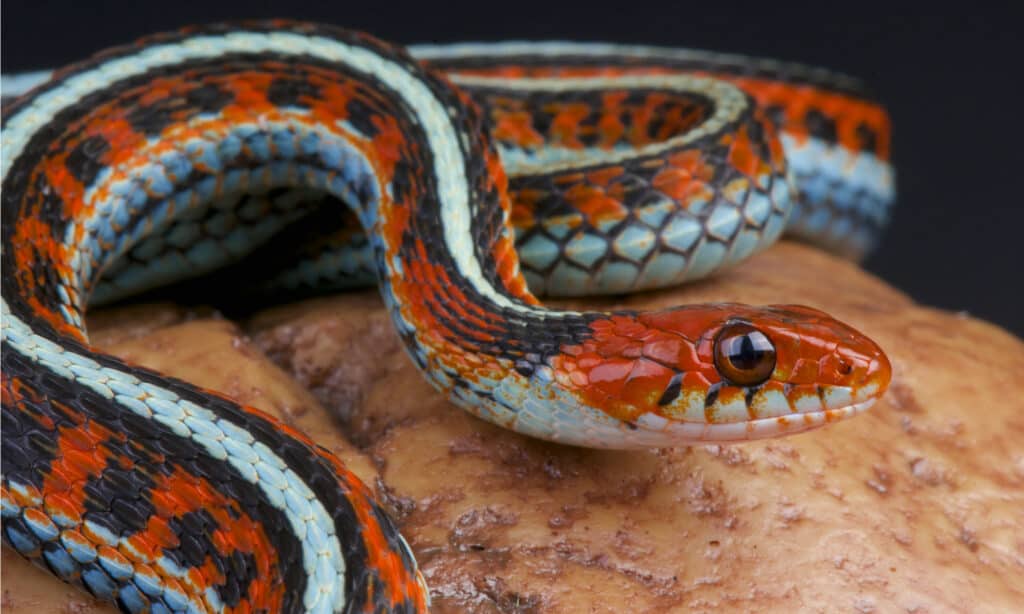
Garter snakes can come in some quite beautiful morphs.
©reptiles4all/Shutterstock.com
You may be wondering, given that they are non-venomous, if the garter snake would be a good choice for a pet. Garter snakes are indeed kept as pets. Though most have vertical yellow stripes, they can come in other color morphs that are quite beautiful. They also have fairly docile personalities, are social, and don’t require too much in the way of habitat. Garter snakes are also fairly inexpensive, ranging from $20-$300.
On the downside, most garter snakes sold were captured in the wild, so will need work to be tamed. They can be squirmy and skiddish, and are not as fond of being handled as some other pet snake species. As mentioned earlier, they are capable of emitting a foul smell. And finally, you may want to reconsider having a garter snake as a pet because some species are mildly venomous, so can cause swelling if you are bitten.
The photo featured at the top of this post is © iStock.com/Ingrid R Kostron
Discover the "Monster" Snake 5X Bigger than an Anaconda
Every day A-Z Animals sends out some of the most incredible facts in the world from our free newsletter. Want to discover the 10 most beautiful snakes in the world, a "snake island" where you're never more than 3 feet from danger, or a "monster" snake 5X larger than an anaconda? Then sign up right now and you'll start receiving our daily newsletter absolutely free.
Thank you for reading! Have some feedback for us? Contact the AZ Animals editorial team.






